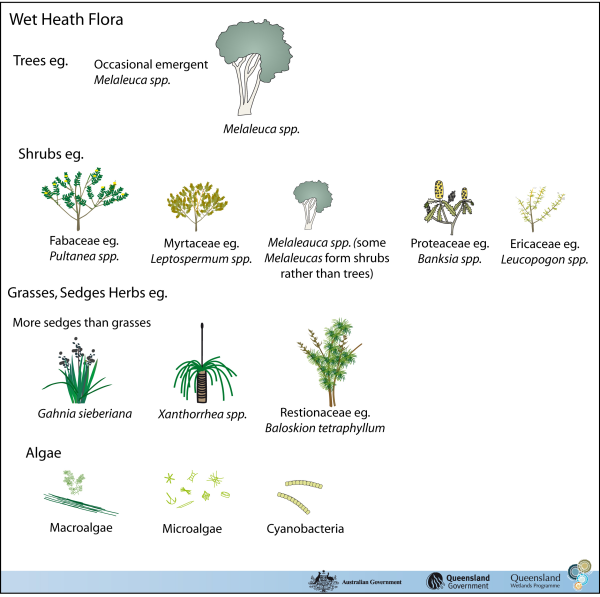|
|
Coastal and subcoastal non-floodplain wet heath swampCoastal and subcoastal non-floodplain wet heath swamp – FloraClick on elements of the model or select from the tabs below
Coastal non-floodplain wet heath swamps are closed or wet heathland, sometimes with stunted emergent shrubs/low trees. Characteristic shrubs include Banksia spp. (especially B. robur) Boronia falcifolia, Epacris spp., Baeckea frutescens, Schoenus brevifolius, Leptospermum spp., Hakea actites, Melaleuca thymifolia, M. nodosa, Xanthorrhoea fulva with Baloskion spp. and Sporadanthus spp. in ground layer. Wet heath are dominated by essentially treeless plant communities of low shrubs and various other ground flora. There are floristic similarities shared by both dry and wet heaths. Plant communities are typically rich in species with the major plant families represented including myrtles (Myrtaceae), proteas (Proteaceae), ericas (Ericaceae), boronias (Rutaceae), wattles (Mimosaceae), peas (Fabaceae), lilies (Liliaceae) and grass-trees and mat-rushes (Xanthorrhoeaceae). In some situations wet heaths may grade into true sedgelands dominated by rushes (Juncaceae), sedges (Cyperaceae) and node-sedges (Restionaceae). Typically heath plants have small, evergreen leaves with a waxy cuticle that display adaptations to combat moisture stress and/or low oxygen soil conditions, as well as extensive root systems, often arising from lignotubers. Heath species often have high oil and carbon content of their leaves, increasing their flammability. Last updated: 22 March 2013 This page should be cited as: Department of Environment, Science and Innovation, Queensland (2013) Coastal and subcoastal non-floodplain wet heath swamp – Flora, WetlandInfo website, accessed 8 May 2025. Available at: https://wetlandinfo.des.qld.gov.au/wetlands/ecology/aquatic-ecosystems-natural/palustrine/non-floodplain-heath/flora.html |

 — Department of the Environment, Tourism, Science and Innovation
— Department of the Environment, Tourism, Science and Innovation




